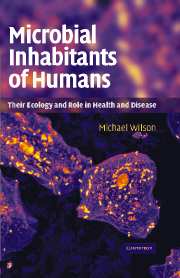Book contents
- Frontmatter
- Contents
- Preface
- Abbreviations used for microbial genera
- 1 An introduction to the human–microbe symbiosis
- 2 The skin and its indigenous microbiota
- 3 The eye and its indigenous microbiota
- 4 The respiratory system and its indigenous microbiota
- 5 The urinary system and its indigenous microbiota
- 6 The reproductive system and its indigenous microbiota
- 7 The gastrointestinal tract and its indigenous microbiota
- 8 The oral cavity and its indigenous microbiota
- 9 Role of the indigenous microbiota in maintaining human health
- 10 Manipulation of the indigenous microbiota
- Index
6 - The reproductive system and its indigenous microbiota
Published online by Cambridge University Press: 06 July 2010
- Frontmatter
- Contents
- Preface
- Abbreviations used for microbial genera
- 1 An introduction to the human–microbe symbiosis
- 2 The skin and its indigenous microbiota
- 3 The eye and its indigenous microbiota
- 4 The respiratory system and its indigenous microbiota
- 5 The urinary system and its indigenous microbiota
- 6 The reproductive system and its indigenous microbiota
- 7 The gastrointestinal tract and its indigenous microbiota
- 8 The oral cavity and its indigenous microbiota
- 9 Role of the indigenous microbiota in maintaining human health
- 10 Manipulation of the indigenous microbiota
- Index
Summary
The only region of the male reproductive system that is colonised by microbes is the urethra, and its indigenous microbiota has already been described in Chapter 5. This chapter, therefore, is devoted to a discussion of the indigenous microbiota of the reproductive system in females.
Anatomy and physiology of the female reproductive system
The female organs of reproduction include the ovaries, Fallopian tubes, uterus, cervix, vagina, and vulva (Figure 6.1). Of these, only the vagina, vulva, and cervix of the uterus are normally colonised by microbes. While a large number of studies have been devoted to elucidating the indigenous microbiota of the vagina and, to a lesser extent, the cervix, relatively little is known with regard to which microbes inhabit the various regions of the vulva.
The vulva is a term used to denote the external female genitalia, which include the mons pubis, labia majora and minora, clitoris, and vestibule (Figure 6.2). The vestibule is lined with a stratified squamous epithelium and located within it are the vaginal orifice, the external urethral orifice, and the openings of the mucus–secreting paraurethral and Bartholins glands. The mons pubis consists of a layer of adipose tissue covered by skin and pubic hair (Table 6.1). The labia majora are longitudinal folds of skin which contain adipose tissue, have sebaceous and sudoriferous glands, and are covered in pubic hair on their outer surfaces.
- Type
- Chapter
- Information
- Microbial Inhabitants of HumansTheir Ecology and Role in Health and Disease, pp. 206 - 250Publisher: Cambridge University PressPrint publication year: 2004
- 1
- Cited by



